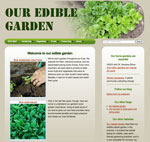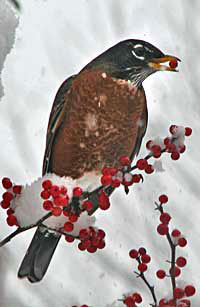Words of Wisdom
Douglas Tallamy
|
 | | Insects are essential food for baby birds |
|
Somehow along the way we have come to expect perfection in our gardens: the plastic quality of artificial flowers is now seen as normal and healthy.
It is neither.
Instead, it is a clear sign of a garden so contrived that it is no longer a living community, so unbalanced that any life form other than the desired plants is viewed as an enemy and quickly eliminated.
Today's gardeners are so concerned about the health of their plants that they run for the spray can at the first sign of an insect.
Ironically, a sterile garden is one teetering on the brink of destruction. It can no longer function as a dynamic community of interacting organisms, all working smoothly to perpetuate their interactions. Its checks and balances are gone.
Instead, the sterile garden's continued existence depends entirely on the frantic efforts of the gardener alone.
~ Douglas Tallamy, Bringing Nature Home: How Native Plants Sustain Wildlife in Our Gardens
2nd ed. pp. 95-96
|
Restoring Montezuma
Wed., Feb. 12
|
 | | Female mallard |
| |
The Onondaga Audubon group is presenting a program on Restoring Montezuma.
The Montezuma Wetlands Complex was named Audubon's first globally significant Important Bird Area.
At this program meeting, Montezuma Audubon Center interim director Chris Lajewski will speak about engaging the community in conserving and restoring habitats at Montezuma.
WHEN: Wed., Feb. 12 at 7:00 pm WHERE: Baldwinsville Public Library 33 E. Genesee St. Baldwinsville Free and open to the public Here's more information
|
HGCNY Officers
| |
| President:
Janet Allen
Vice-President:
Carol Biesemeyer
Treasurer:
Randi Starmer
Secretary:
Soule Leiter
Membership:
Linda Rossiter
Program Chair:
Carol Biesemeyer
Newsletter Editor:
Janet Allen
Additional Planning Committee Members:
Beth Mitchell
Dave Mitchell
John Allen
|
| Our Habitat Garden |  |
Visit Our Habitat Garden website for information on providing habitat, earth-friendly gardening practices, plants, and various creatures here in Central New York. TIP: Click on each sliding menu item as you navigate through the menus to pin them down instead of sliding away.
|
| HGCNY on Facebook |
As as more of us participate on our Facebook page, this will become a useful resource for asking (and answering!) local HGCNYers' questions about habitat gardening. |
|
Join HGCNY!
|  |
Becoming an official member of HGCNY is easy: just join Wild Ones! Basic household membership is $37/year, but there are other options, too. (See membership application or website.)
Wild Ones
P.O. Box 1274
Appleton, Wisconsin 54912-1274
Make checks payable to Wild Ones.
Or telephone toll-free 877-394-9453.
|
|
Our Edible Garden
|  | Visit OurEdibleGarden.org to see an example of a Central New York edible garden, the perfect companion to your habitat garden.
|
|
 | Red oak leaves
Native oak trees
(Quercus spp.) are Biodiversity All-Stars!
|
Over the last few years we've referred frequently to Douglas Tallamy, author of the highly acclaimed book Bringing Nature Home: How You Can Sustain Wildlife with Native Plants.
Our February meeting provides an opportunity to hear Dr. Tallamy speak.
No, we don't have him here in person (YET...but we're working on it!), but we have the next best thing: a video recording of one of his presentations given to another Wild Ones chapter, which generously distributed DVDs of the presentation to other chapters.
A video? People who in the past have been subjected to videos of presentations may wonder whether it's worth coming to see a video. We wondered the same thing, so our HGCNY Planning Group previewed it last year. We found that not only were the production qualities very good, but that seeing and hearing Dr. Tallamy extended our understanding of the ideas he presented in his book. We were glad we saw it. We think you'll find it to be as rewarding and inspiring as we did.
Dr. Tallamy explains why native plants are important to preserving biodiversity and makes a compelling, scientifically-sound case for landscaping with native plants. He is a very popular and entertaining speaker and has inspired many thousands of home gardeners to plant native plants.
WHEN: Sunday January 26 at 2:00 pm WHERE: Liverpool Library (Directions)
We meet the last Sunday of the month, and our meetings are free and open to the public. Come and bring a friend! Gardening with native plants appreciated in the Town of DeWittRecently, the Parrat Schick Award of Excellence was awarded to a project that Dave Mitchell, a member of the HGCNY Planning Committee, helped plan. In a tough environment near a busy street, natives stand out to provide visual interest throughout the growing season and beyond. The 6th Annual Ithaca Native Landscape Symposium March 7th and 8thThe Symposium offers alternative ideas, knowledge and perspectives presented by experts and professionals from our region and beyond. It's not just for professionals. Master Gardeners, homeowners, naturalists and anyone else eager to learn more about this growing movement are welcome! For more information and to register ...
Janet Allen
President, HGCNY
|
|
|
THIS WEEK! Mark your calendar for the Great Backyard Bird Count
Friday Feb. 14 - Monday Feb. 17

This annual four-day event engages bird watchers of all ages in counting birds to create a real-time snapshot of where the birds are.
Read more about the Great Backyard Bird Count ...
Everyone is welcome from beginning bird watchers to experts.
It takes as little as 15 minutes on one day, or you can count for as long as you like each day of the event. It's free, fun, and easy--and it helps the birds.
Participants tally the number of individual birds of each species they see during their count period and enter these numbers on the GBBC website.
To make it even easier, the GBBC provides a list of all the birds you're likely to see in the Central New York region during the month of February. Just plug in your zipcode on this webpage.
New participants must set up a free GBBC account to submit their checklists or use login information from an existing account for any other Cornell Lab citizen-science project. You'll only need to do this once to participate in all future GBBC events.
A free BirdLog GBBC app!
Thanks to support from Pennington, the BirdLog eBird app is now being offered for free right now for both iPhone and Android smartphone operating systems. You can use the app any time between now and February 28 to submit your checklists to eBird. Your sightings will be included in the Great Backyard Bird Count if you use the app during February 14-17. You can log in with your existing GBBC/eBird account or create an account if you don't already have one.
[Editor's Note: After attending the presentation by the BirdLog's creator at the Fayetteville Library last November, I purchased the app and have found it to be very enjoyable and useful.]
|
 | |
Common milkweed (Asclepias syriaca)
Monarchs must have milkweed to survive!
|
Monarchs in the news
The recently-released figures on the size of the overwintering monarch population were not unexpected, but still devastating. The population is at a record low.
The official estimate (always reported in size of the area occupied by monarchs)
is a mere 1.6 acres. Just a tad over an acre and a half for all the monarchs in the eastern North American population!
At 20 million butterflies per acre, that's only 33 million monarchs compared to a peak of 1 billion in 1996.
How can we help preserve the migration?
As Dr. Karen Oberhauser says, "Individuals can help by planting locally sourced, native milkweed and nectar plants, and by spreading the word. It's important to use local plants because some varieties, especially those planted year-round in some southern states, have led to disturbances in the migratory patterns.
Individuals also can help by asking property managers and local governments to avoid mowing milkweed plants when monarch eggs and caterpillars might be present, and by avoiding insecticides."HGCNY will again be offering some locally-sourced milkweeds, grown for us by The Plantsmen Nursery. We CAN make a difference, but we have to start now! Read a hopeful story of h ow one person restored monarch habitat on her previously degraded property. Read more on Journey North about Why the Decline?Read more about the Wild Ones Wild for Monarchs program, part of the Monarch Joint Venture. And for history buffs, here is a fascinating article about how milkweed saved lives in WWII.
|
 | | Robin eating winterberries |
Robins in winter
Not all robins leave town for the winter. How do they survive?
According to Journey North, food is even more important than shelter in cold weather. It fuels metabolism, giving robins the fat and energy they need to move, stay warm, and survive.
But what do they NOT eat? Bird seed! They don't come to seed feeders as many other birds do.
Many of our native plants, though, help them make it through the long, cold winter.
Winterberries (Ilex verticillata), a native holly, are a favorite, and they even eat the wizened-up remaining berries in the spring when other food is still in short supply.
Some other native plants providing winter food for robins are Virginia creeper (Parthenocissus quinquefolia) and sumac (Rhus typhina).
Besides food, many of our native evergreens can provide shelter from the cold.
Learn more about robins in winter in this slide show from Journey North.
|
|
|
|
|